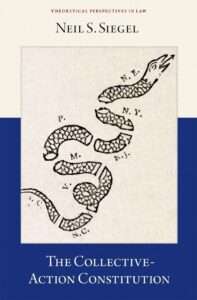

Something like the idea animating The Collective-Action Constitution—or a narrower, more implicit, and more intuitive version of it—has been around for a long time and has been articulated in many places. At the Philadelphia Convention and state ratifying conventions, and in public essays and private correspondence, Madison, Hamilton, Wilson, Washington, and other prominent nationalists emphasized both the need for federal power in cases of general interests, separate state incompetence, or regulatory disuniformity and the need to stop states from creating interstate problems. The Constitution was drafted and ratified primarily to achieve these goals, not to limit federal power or to protect state authority or individual liberty.
John Marshall was at the Virginia ratifying convention, and collective-action reasoning supports—and may have informed—canonical federalism decisions of the Marshall Court. The most important example is McCulloch v. Maryland (1819), which embodies the book's argument. The Court upheld federal power to create a national bank as convenient to carrying into execution federal powers that solve collective-action problems for the states, and prohibited states from causing collective-action problems by taxing the bank. Another example is Gibbons v. Ogden (1824), which upheld federal power to regulate navigation under the Interstate Commerce Clause, thereby preventing states from causing collective-action problems by granting monopoly power over navigation routes.
Over the nineteenth century, federal courts helped entrench a political and economic union by policing state protectionism. Collective-action reasoning supported and likely influenced their invalidation of state laws under the dormant commerce doctrine, which today limits the extent to which states can cause collective-action problems by being protectionist or burdening interstate commerce.
In the early twentieth century, the federal government made—and the Supreme Court rejected—collective-action arguments in important federalism cases. One example is Hammer v. Dagenhart (1918), which invalidated a federal ban on the shipment in interstate commerce of goods produced by child labor. The Court there blessed a regulatory race to the bottom. A distinguishing feature of the Court's federalism jurisprudence from the late 1800s to the 1930s was its frequent rejection of the idea that multistate collective-action problems partially justify federal power.
Informal expressions of the collective-action concept ramped up during the New Deal and Great Society. Robert Stern, a lawyer for the federal government who overcame anti-Semitism to build a great life in the law, authored a stunning law review article that presaged modern theorizing about the relationship between the Interstate Commerce Clause and the regulation of multistate collective-action problems. Certain Supreme Court briefs filed by the federal government during the Great Depression reflected Stern's research and thinking. (See pages 7-8 of The Collective-Action Constitution for citations.) Perhaps relatedly, collective-action rationales seemed to inform transformative federalism decisions of the Court during the constitutional crisis of the New Deal, just after the "switch in time that saved nine" in 1937: NLRB v. Jones & Laughlin Steel Corporation, Steward Machine Company v. Davis, and Helvering v. Davis.
During the post-New Deal era that reoriented constitutional law, the Court invoked collective-action logics in justifying Congress's power to regulate interstate commerce. One example is United States v. Darby (1941), which overruled Hammer v. Dagenhart in upholding federal minimum-wage and maximum-hours regulations of manufacturers of goods shipped in interstate commerce. Another example is Wickard v. Filburn (1942), which validated Congress's attempt to raise the price of wheat on the interstate market by upholding a federal wheat-production quota as applied to a farmer who exceeded his quota but used the excess wheat for home consumption and livestock feeding. The Court also implicitly used collective-action thinking in continuing to invalidate state laws under the dormant commerce doctrine in such cases as H.P. Hood & Sons, Inc. v. Du Mond (1949).
Similarly, collective-action reasoning supports the Court's decisions upholding the Civil Rights Act of 1964 just after it was passed. This is (of course) not because collective-action problems impeded the ability of all states, Southern ones included, to champion racial equality and facilitate the interstate mobility of African Americans. Rather, the Court's decisions in Heart of Atlanta Motel, Inc. v. United States (1964) and Katzenbach v. McClung (1964) were lawful because Southern racism impeded the ability of most other states to protect interstate travel by African Americans, and the Interstate Commerce Clause lets Congress settle disagreements among states about whether collective action is warranted in the commercial sphere—and to pursue this goal when accomplishing it would benefit the rest of the states more than it would harm majorities of the electorate in Southern states. To act, Congress need not first prove empirically that all states have been trying and failing to pursue the regulatory regime in question; like in Darby and Wickard, it suffices for Congress to rationally conclude that the states face a cost-benefit collective-action problem.
The current era saw an increase in use of the collective-action idea on and off the Court. One example is United States v. Lopez (1995), where the Court likely sensed the absence of a multistate collective-action problem within a reasonable time horizon. For the first time since the 1930s, the Court declared a federal law—a ban on firearms possession in school zones—beyond the Interstate Commerce Clause. Another example is Gonzales v. Raich (2005), where the Court seemed to offer a collective-action rationale in holding that Congress can use its interstate-commerce power to prohibit the local cultivation and use of marijuana in compliance with state law permitting such use. As in Wickard, the Court deemed reasonable the federal government's concern about diversion of the regulated products across state lines—cost externalizations that Congress could reasonably deem to exceed internalized benefits.
Turning to contemporary legal scholarship, collective-action reasoning has explicitly appeared in the writings of an ideological diverse group of constitutional law scholars, judges, and attorneys, most of whom have focused on the Interstate Commerce Clause. Prominent examples include Michael McConnell, Jacques LeBoeuf, Donald Regan, Richard Levy, Robert Bork and Daniel Troy, Maxwell Stearns, Akhil Amar, Stephen Williams, Jack Balkin, Andrew Koppelman, and Stephen Calabresi. Robert Cooter and I expanded the scope of analysis from the Interstate Commerce Clause to Article I, Section 8. (For citations, see pages 10-11 of the book.)
So, even judging from this incomplete sketch of the role of collective-action reasoning in American constitutional thought over the past two-plus centuries, it seems fair to describe this idea as important, enduring, and, at times, influential.
It is revealing that collective-action thinking has a history; if it were entirely novel, it could not provide the basis for a persuasive structural theory of the Constitution. To date, however, the idea has not been examined rigorously and comprehensively. As noted, past discussions have been relatively casual, implicit, or intuitive. Or they have lumped collective-action problems together with other concepts such as interstate externalities, without distinguishing among different kinds of collective-action problems or specifying the analytical relationship between them and spillover effects. Or else they have focused on specific constitutional provisions, especially the Interstate Commerce Clause.
The Collective-Action Constitution leverages conventional legal and historical materials, as well as concepts and insights from political science and economics, to examine the extent to which collective-action logics illuminate the Constitution as a whole—the document, its Founding history, its underlying structural principles, and its evolving interpretation outside and inside the courts. The book's conclusion is that a collective-action account has significant explanatory power descriptively and normatively, but that it also has limits. Identifying the limits of the theory is as important as identifying its promise, because the limits help define the idea of collective action more sharply and give it greater explanatory power where it does apply. The book shows the great extent—previously underappreciated—to which the Constitution empowers the federal government to solve collective-action problems for the states and prohibits states from thwarting federal solutions to such problems or generating them.
The book also clarifies the contexts in which other rationales are required to justify federal power, especially legislative and judicial protection of most constitutional rights. Rights protection concerns how a state relates to its own inhabitants, which is a different question from how it relates to sister states or the federal government. Accordingly, the Collective-Action Constitution must be supplemented with what the book calls the Reconstruction Constitution to capture the functions of the Constitution more fully in modern America. Even regarding rights protection, however, the book argues that collective-action reasoning plays a role.
The post The Collective-Action Constitution: A Brief History of an Idea appeared first on Reason.com.







